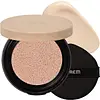What's inside
What's inside
 Key Ingredients
Key Ingredients

 Benefits
Benefits

 Concerns
Concerns

 Ingredients Side-by-side
Ingredients Side-by-side

Petrolatum
EmollientLanolin Oil
EmollientCaprylic/Capric Triglyceride
MaskingAluminum Starch Octenylsuccinate
AbsorbentParaffin
PerfumingPolyethylene
AbrasiveSorbitan Sesquioleate
EmulsifyingGlyceryl Tribehenate/Isostearate/Eicosandioate
EmollientMicrocrystalline Wax
Emulsion StabilisingTocopheryl Acetate
AntioxidantAscorbyl Tetraisopalmitate
AntioxidantEthylhexylglycerin
Skin ConditioningSalmon Egg Extract
Water
Skin ConditioningGlycerin
HumectantSteareth-20
CleansingN-Hydroxysuccinimide
Skin ConditioningDiacetyl Boldine
Skin ConditioningPalmitoyl Tripeptide-1
Skin ConditioningChrysin
Skin ConditioningPalmitoyl Tetrapeptide-7
Skin ConditioningAlpha-Isomethyl Ionone
PerfumingLinalool
PerfumingButylphenyl Methylpropional
PerfumingPetrolatum, Lanolin Oil, Caprylic/Capric Triglyceride, Aluminum Starch Octenylsuccinate, Paraffin, Polyethylene, Sorbitan Sesquioleate, Glyceryl Tribehenate/Isostearate/Eicosandioate, Microcrystalline Wax, Tocopheryl Acetate, Ascorbyl Tetraisopalmitate, Ethylhexylglycerin, Salmon Egg Extract, Water, Glycerin, Steareth-20, N-Hydroxysuccinimide, Diacetyl Boldine, Palmitoyl Tripeptide-1, Chrysin, Palmitoyl Tetrapeptide-7, Alpha-Isomethyl Ionone, Linalool, Butylphenyl Methylpropional
Water
Skin ConditioningCI 77891
Cosmetic ColorantHomosalate
Skin ConditioningCyclopentasiloxane
EmollientZinc Oxide
Cosmetic ColorantButylene Glycol
HumectantMethyl Trimethicone
Skin ConditioningButyloctyl Salicylate
Skin ConditioningEthylhexyl Salicylate
UV AbsorberLauryl PEG-10 Tris(Trimethylsiloxy)Silylethyl Dimethicone
EmulsifyingIsododecane
EmollientNiacinamide
SmoothingPEG-10 Dimethicone
Skin ConditioningMica
Cosmetic ColorantMagnesium Sulfate
Trimethylsiloxysilicate
EmollientMethyl Methacrylate Crosspolymer
Disteardimonium Hectorite
StabilisingAcrylates/Stearyl Acrylate/Dimethicone Methacrylate Copolymer
Caprylic/Capric Glycerides
EmollientPvp
Emulsion StabilisingAcrylates/Polytrimethylsiloxymethacrylate Copolymer
Skin ConditioningTriethoxycaprylylsilane
Aluminum Hydroxide
EmollientCetyl Alcohol
EmollientParfum
MaskingAdenosine
Skin ConditioningDimethicone
Emollient1,2-Hexanediol
Skin ConditioningTocopherol
AntioxidantMelilotus Officinalis Extract
AstringentPyrus Cydonia Fruit Extract
Skin ConditioningCitrus Aurantium Dulcis Fruit Extract
MaskingTitanium Dioxide
Cosmetic ColorantCI 77492
Cosmetic ColorantCI 77491
Cosmetic ColorantCI 77499
Cosmetic ColorantWater, CI 77891, Homosalate, Cyclopentasiloxane, Zinc Oxide, Butylene Glycol, Methyl Trimethicone, Butyloctyl Salicylate, Ethylhexyl Salicylate, Lauryl PEG-10 Tris(Trimethylsiloxy)Silylethyl Dimethicone, Isododecane, Niacinamide, PEG-10 Dimethicone, Mica, Magnesium Sulfate, Trimethylsiloxysilicate, Methyl Methacrylate Crosspolymer, Disteardimonium Hectorite, Acrylates/Stearyl Acrylate/Dimethicone Methacrylate Copolymer, Caprylic/Capric Glycerides, Pvp, Acrylates/Polytrimethylsiloxymethacrylate Copolymer, Triethoxycaprylylsilane, Aluminum Hydroxide, Cetyl Alcohol, Parfum, Adenosine, Dimethicone, 1,2-Hexanediol, Tocopherol, Melilotus Officinalis Extract, Pyrus Cydonia Fruit Extract, Citrus Aurantium Dulcis Fruit Extract, Titanium Dioxide, CI 77492, CI 77491, CI 77499
Alternatives
Ingredients Explained
These ingredients are found in both products.
Ingredients higher up in an ingredient list are typically present in a larger amount.
Water. It's the most common cosmetic ingredient of all. You'll usually see it at the top of ingredient lists, meaning that it makes up the largest part of the product.
So why is it so popular? Water most often acts as a solvent - this means that it helps dissolve other ingredients into the formulation.
You'll also recognize water as that liquid we all need to stay alive. If you see this, drink a glass of water. Stay hydrated!
Learn more about Water